Pardon my submarine reference in the title but I’m betting many of my readers are old enough to remember those old WWII movies.
I seldom see Pied-billed Grebes use this unique diving method but it always amuses me when I do. I’ve reported on this behavior before but those were different photos and this is a different grebe.
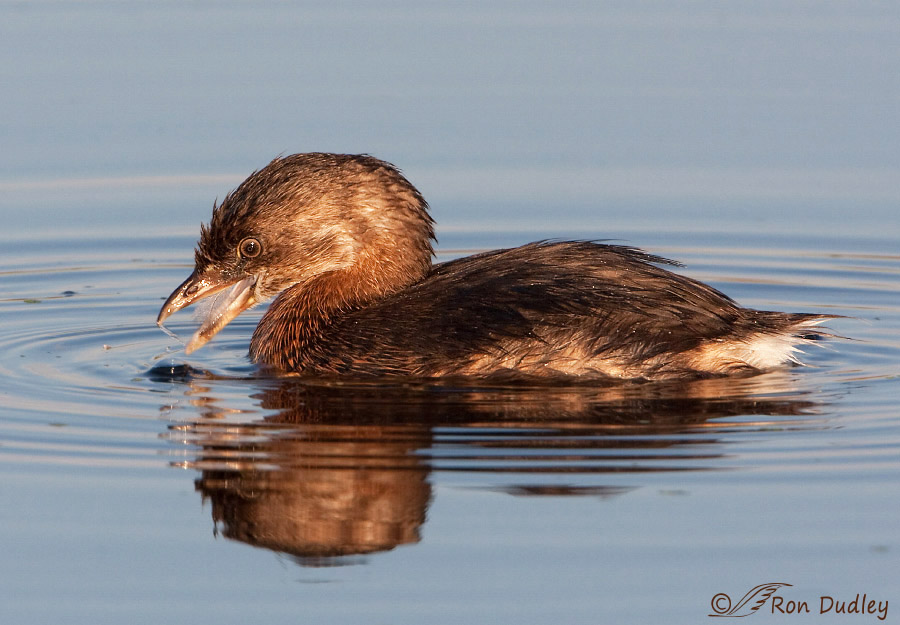
This shot isn’t part of the series. I’ve only included it to show the angle at which a Pied-billed Grebe normally sits on the water and I didn’t get a photo like it in the actual series. The image is cropped unusually tight for another purpose in a different post (to give viewers a closer look at the feather the grebe is eating).
Notice how far the junction of the back of the neck and the body is from the water’s surface. These birds are quite buoyant.
The following 4 images are a series in a burst without any skips.
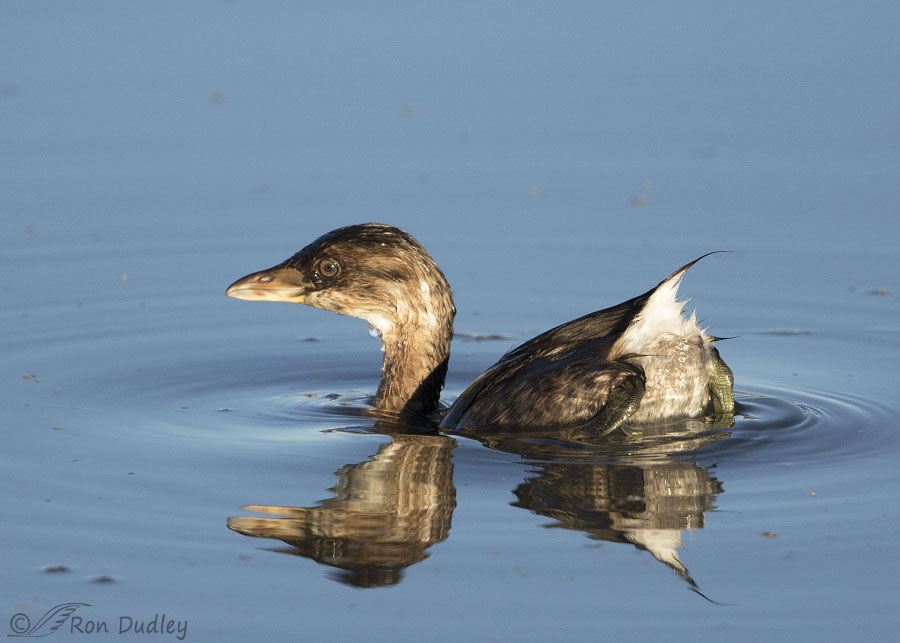
1/2500, f/5.6, ISO 640, Canon 7D Mark II, Canon EF 500mm f/4L IS II USM + EF 1.4 III Extender, not baited, set up or called in
But when they use this diving technique they simply sink straight down and disappear with no forward movement. This bird has already started to sink but they don’t stay level during the process. Instead the front of their body goes down first with the tail and head lagging behind. Makes sense – that body shape would be like a wedge sinking in the water which would cause less water resistance.
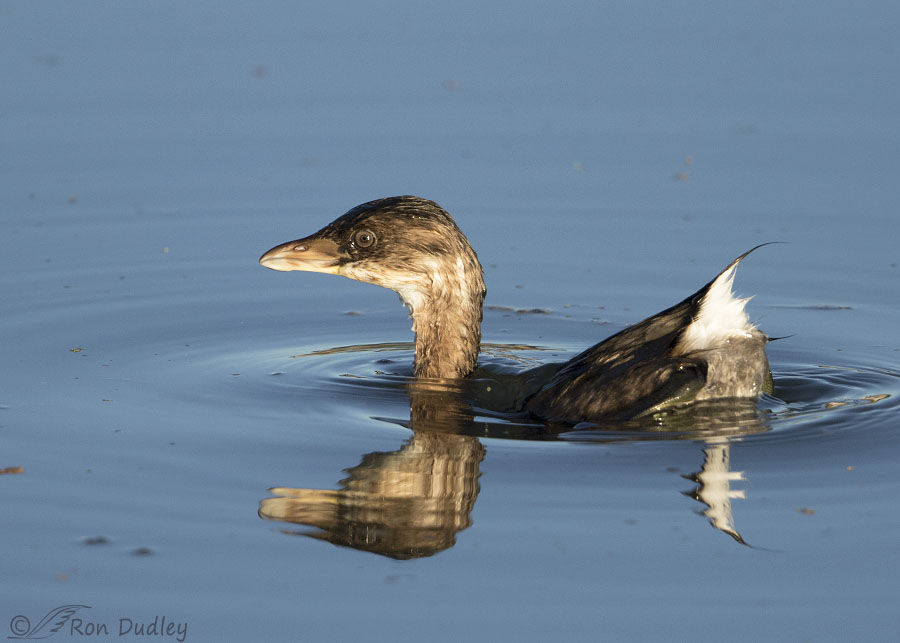
1/3200, f/5.6, ISO 640, Canon 7D Mark II, Canon EF 500mm f/4L IS II USM + EF 1.4 III Extender, not baited, set up or called in
At first the process is often slow, though they can control the speed and if they need to they can sink much faster. In this case there’s only been slight movement down between the first photo and the second.
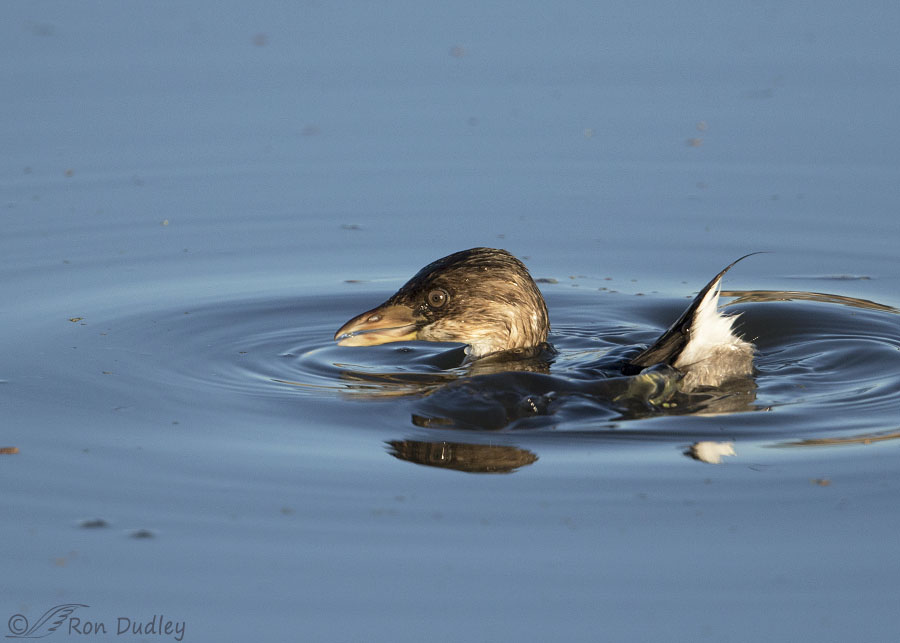
1/3200, f/5.6, ISO 640, Canon 7D Mark II, Canon EF 500mm f/4L IS II USM + EF 1.4 III Extender, not baited, set up or called in
But then the descent quickens until only the head and tail are sticking up out of the water. I’ve photographed this process where the water level is right at the bottom of the eye so we can see only the eye and above and the very tip of the tail. And they can hold that position for as long as they like. But usually they don’t.
Notice from the water ripples that there’s still no forward movement of the bird – none at all. All movement is straight down.
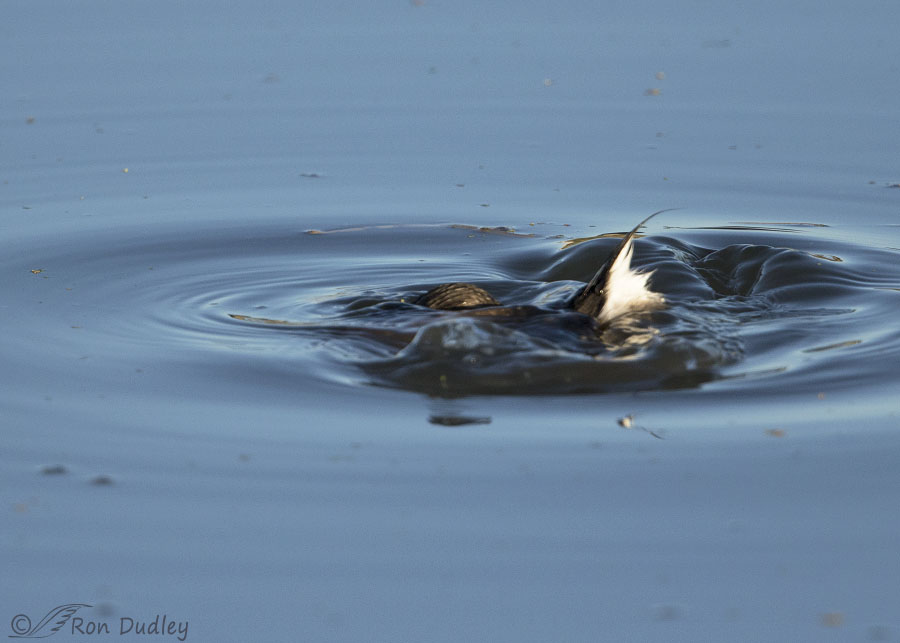
1/3200, f/5.6, ISO 640, Canon 7D Mark II, Canon EF 500mm f/4L IS II USM + EF 1.4 III Extender, not baited, set up or called in
In this last shot the bird had all but disappeared under the surface.
Here’s how Cornell’s Birds of North America Online describes this process they call “Gradual Sinking”.
- “Gradual Sinking: Changes buoyancy by expelling air from between feathers and body, and from air sacs. Sinks to any desired depth, with various amounts of body, or neck and head, above surface. Bill and tail disappear last; pushes water up over back with feet.”
I’d quibble with BNA over one tiny thing. In my experience it’s always been the top of the head (plus the tail} that disappears last instead of the bill, as it was here.
Pied-billed Grebes are the only species I’ve ever seen do this. I can’t say for certain that some of the other smaller grebe species don’t do it but I’m confident that larger Western and Clark’s grebes do not because I’ve spent so much time with them and never seen them do it. I’ve never seen Eared Grebes do it either but I’ve spent less time with them up close.
Horned, Least and Red-necked Grebes I’m less sure of. Perhaps it’s a function of size.
Ron


Definitely makes me think of a submarine! I can just hear the dive alarm going off. Down periscope…
Dive! Dive! The reference is completely unfamiliar to me. And I have a fine bridge I would be happy to sell you…
Late to the party (for the same totally infuriating reason) and intrigued and delighted.
Thanks, EC. When I saw you commenting so late I just knew it had to be computer problems again. I feel for you…
Great story! I am wondering why this Grebe hasn’t the pied bill. I would think it would be in breeding plumage; perhaps a juvenile?
Thanks, Lyle. These photos were taken on 10/26/15. It wasn’t breeding season then.
Fascinating! I cant wait to view these birds some day. Great photos!
I hope you get to see them dive like this, Joanne.
Fun series. The ability to choose whether to float or sink is something I have a hard time wrapping my brain around.
Thank you, Susan. For them it’s almost like flooding or emptying their ballast tanks… 🙂
Same here…
Hi Ron,
I graduated from sub school a million years ago, and served on a boomer, the USS Alexander Hamilton. Brings me back…And I love to watch pied-billeds “slow blow” – maybe they’ll evolve a snorkel. 😀
Cheers,
Dick
“maybe they’ll evolve a snorkel”
I got a kick out of that, Dick.
“Slow blow” is an excellent name for it, even though it sometimes isn’t slow at all.
Beautiful photos Ron. Love the full body reflections. Have never seen one do that although I have seen one dive and catch a small fish. Dive Dive is very familiar sound to me – I took submarine training in New London Connecticut many many years ago, but had to drop out due to severe allergies there in New England that affected my breathing to the point that I was not doing well on pressure tests.
Everett Sanborn, Prescott AZ
Thanks, Everett. I’ll bet those words DO bring back memories for you!
Wow, Ron – I love your series today because this is a new behavior that I haven’t had a chance to see. I love the Pied-bill Grebes we have at Green Cay Wetlands & always look for them when walking the boardwalk. Such a neat species to watch & now I’ll hang around for a chance to watch this particular behavior!! So KOOL!! Oh yes & I’m old enough to remember the submarine movies!!! Dive, Dive, Dive!!
Jo Ann, I think these nondescript little grebes are one of the most interesting species to photograph when it comes to behaviors. They’re both feisty and fast so they’re a challenge to shoot though.
Apt title, a sub almost does the same thing, sort of! Great, sharp as a tack (to me). Love the sequence.
I enjoy those old movies – shows my age I guess!
How are you doing with the temps?
We had 5 days of 90’s, However, today we finally are out of the heat and humidity, 48F when I got up this AM, not supposed to get above 75 today. Ideal!
Wed. morning it was 35 in North Central MT and made 102 yesterday – nutsy weather………..
That’s crazy but not particularly unusual in MT. It got to 105 here yesterday and the AC was going when I got up at 4 AM.
Yeah, the main difference between subs and these birds is that subs are usually moving forward during the descent.
See my response to Judy about our heat, Dick. In temps like this our air in the valley is always a mess with ozone and pollutants.
I feel for you guys when it is that hot.
VERY cool and interesting series Ron! 🙂 Amazing that they have the control over adding/removing air from their air sacs and from between feathers. Yes, some of us are of an age where “Dive, Dive” is meaningful…….;)
I remember some of those old movies quite well, Judy.
You can actually see most diving birds expel air from between their feathers just before a more typical dive because when they do it their entire body contracts in size – similar to putting a balloon into a positive pressure chamber. If you’re trying to photograph dives that’s a good thing to watch for.